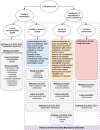Human-centered evaluation of explainable AI applications: a systematic review
- PMID: 39484154
- PMCID: PMC11525002
- DOI: 10.3389/frai.2024.1456486
Human-centered evaluation of explainable AI applications: a systematic review
Abstract
Explainable Artificial Intelligence (XAI) aims to provide insights into the inner workings and the outputs of AI systems. Recently, there's been growing recognition that explainability is inherently human-centric, tied to how people perceive explanations. Despite this, there is no consensus in the research community on whether user evaluation is crucial in XAI, and if so, what exactly needs to be evaluated and how. This systematic literature review addresses this gap by providing a detailed overview of the current state of affairs in human-centered XAI evaluation. We reviewed 73 papers across various domains where XAI was evaluated with users. These studies assessed what makes an explanation "good" from a user's perspective, i.e., what makes an explanation meaningful to a user of an AI system. We identified 30 components of meaningful explanations that were evaluated in the reviewed papers and categorized them into a taxonomy of human-centered XAI evaluation, based on: (a) the contextualized quality of the explanation, (b) the contribution of the explanation to human-AI interaction, and (c) the contribution of the explanation to human-AI performance. Our analysis also revealed a lack of standardization in the methodologies applied in XAI user studies, with only 19 of the 73 papers applying an evaluation framework used by at least one other study in the sample. These inconsistencies hinder cross-study comparisons and broader insights. Our findings contribute to understanding what makes explanations meaningful to users and how to measure this, guiding the XAI community toward a more unified approach in human-centered explainability.
Keywords: XAI; XAI evaluation; explainable AI; human-AI interaction; human-AI performance; human-centered evaluation; meaningful explanations; systematic review.
Copyright © 2024 Kim, Maathuis and Sent.
Conflict of interest statement
The authors declare that the research was conducted in the absence of any commercial or financial relationships that could be construed as a potential conflict of interest.
Figures








References
-
- Abdul A., von der Weth C., Kankanhalli M., Lim B. Y. (2020). “COGAM: measuring and moderating cognitive load in machine learning model explanations,” in Proceedings of the 2020 CHI Conference on Human Factors in Computing Systems (New York, NY: ACM; ), 1–14. 10.1145/3313831.3376615 - DOI
-
- Adhikari A., Tax D. M., Satta R., Faeth M. (2019). “LEAFAGE: example-based and feature importance-based explanations for black-box ML models,” in 2019 IEEE international conference on fuzzy systems (FUZZ-IEEE) (New Orleans, LA: IEEE; ), 1–7. 10.1109/FUZZ-IEEE.2019.8858846 - DOI
-
- Aechtner J., Cabrera L., Katwal D., Onghena P., Valenzuela D. P., Wilbik A., et al. . (2022). “Comparing user perception of explanations developed with XAI methods,” in 2022 IEEE International Conference on Fuzzy Systems (FUZZ-IEEE) (Padua: IEEE; ), 1–7. 10.1109/FUZZ-IEEE55066.2022.9882743 - DOI
-
- Alufaisan Y., Marusich L. R., Bakdash J. Z., Zhou Y., Kantarcioglu M. (2021). Does explainable artificial intelligence improve human decision-making? Proc. AAAI Conf. Artif. Intell. 35, 6618–6626. 10.1609/aaai.v35i8.16819 - DOI
Publication types
LinkOut - more resources
Full Text Sources
Miscellaneous

